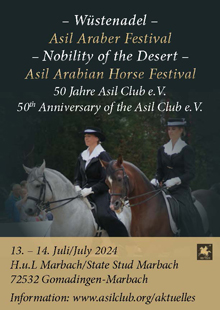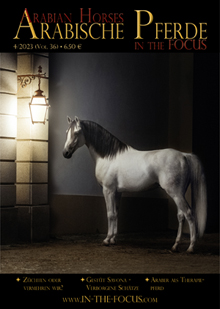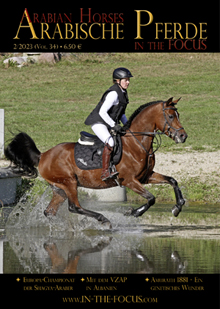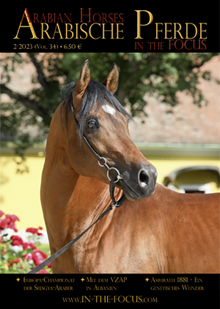The Bouthieb Initiative wants to get endurance riding back to its old values, where more horsemanship and less speed are awarded.

One who wants to change the attitude of his countrymen to the horse and the endurance sport by giving a good example and by teaching the young generation, is H.H. Sheikh Sultan Bin Zayed Al Nahyan in Abu Dhabi. With his Bouthieb initiative, he takes a different approach, for the Arab world this is actually quite a new one.
Setting a good example
When the UAE were temporarily suspended by the FEI in March 2015 due to several incidents, such as dead horses, rule breaches and cheating in the way of fake ride results, many of those responsible in the UAE were quite indignant. Sheikh Sultan, however, took this opportunity and introduced for the endurance season 2015/2016 his Bouthieb Rules at his endurance centre. Bouthieb is a “endurance village” similar to Al Wathba or the Dubai International Endurance City (DIEC) and came into existence in 2006. Here, each year about one third of the rides in UAE took place with up to 500 starts per ride. But since two years, at Bouthieb the fitness and health of the horse is placed higher than the speed, even to the extend, that the speed is limited to max. 20 km/h, because “speed kills”!
There are several different considerations that have finally shaped to the Bouthieb Rules: They are aiming to further good horsemanship (i.e. the fair handling and treatment of horses) and increase horse welfare during the rides – but also during the training, if these rules are considered there, too. It is an attempt, to take endurance riding back to its roots, when it was still a versatile test for equestrian skills and the conditional characteristics of the horse. The goal is to develop an objective evaluation system, that rewards good horses and good horsemanship, always with the welfare of the horse at its core.
Education is needed
The Bouthieb Initiative of Sheikh Sultan also includes the Bouthieb Academy, where local teens are able to learn riding free of cost, and at the same time are taught horsemanship as well. This means, for example, that they groom and saddle their horses themselves – not at all common in the UAE. By doing so, they learn that the horse is not a sports equipment, but a partner, whose mood and ability or willingness to perform can be felt, if you know it well enough.
The Bouthieb Protocoll is in use since the 2015/2016 season and is being used for all CEN’s at Bouthieb. For the CEI’s, the “Best Endurance Challenge Award” (BECA) represents an additional award, considered by many as more important than the FEI result. The Bouthieb Rules are based on a objective points system, with underlying criteria such as optimum speed, recovery time, cardiac recovery index (CRI), metabolic criteria and gait. So far, there have been about 2700 starts at the Bouthieb rides and not one “Catastrophic Injury” was recorded, no fatal injury on the track; only one horse died the following day due to colic (but these cases are not recorded as CIs for the other rides either).
When in March the endurance season comes to an end in the UAEm, the results of two season will be available. Additionally, in 2016 several rides took place abroad, who were organised according to Bouthieb rules (with modifications where necessary) with an “Best Endurance Challenge Award”, for example the 120 and 160 km rides at Marbach, Germany and the Persik Trail in France. Also these results, experiences and feedback from the organisers have been included.
Rule Changes since 2015/2016
Based on the findings and experience gained, the Bouthieb Rules were slightly adapted. So, 20 km/h is still considered to be the optimum speed, but the penalty points for riding too fast between 20,00 and 20,99 km/h have been reduced. However, those riding faster than 21,0 km/h will still be disqualified from the BECA Award. The optimum speed may be adapted (lowered) for rides outside UAE, but one needs to consider that with a technically demanding course the speed rarely exceeds 20 km/h – the “speed limit”, which many riders consider as a “restriction”, does not play a role at all!
For the Recovery Index (RT), there are (only) max. 20 points, the heartbeat has to be at 56 beats per minute after max. 10 minutes presentation time. Outside the UAE, the pulse may modified, such was the case at Marbach last year, when it was fixed at 60 beats per minute.
Also, the Cardiac Recovery Index (CRI) was modified according to new findings: If the second heart rate, measured 1 minute after the horse has started to trot, is no more than 2 beats above the first, two points will be awarded. If the second heart beat is more than 2 beats above the first, no point will be awarded. If the pulse is above the 56 bpm, the horse is called for a heart re-inspection.
The detailed points system for the BECA you can find on our website under “The Bouthieb Rules explained” (www.in-the-focus.com/2017/03/die-bouthieb-regeln-erklaert).
A significant change, which took place for the 2016/2017 season at Bouthieb was to go “back to natural trails”. These natural trails now account for about 30-50 % of the track of each loop, and are accepted by the riders – and horses! – gladly. Automatically, due to these sections of the track, the speed was reduced, because due to reasons of the surface (sand, curves) only trot is possible. This will have to change – on the long run – also the riding style, because the commonly practiced “Harley Davidson” style, with extremely long stirrups and straight legs will then hardly be possible.
The Bouthieb Conference 2017
In March 2017, Sheikh Sultan invited several international representatives from the endurance scene and press for his Bouthieb Conference in Abu Dhabi, to see these rules in practice at the 11th Bouthieb Festival. In dedicated presentations and lively discussions, the differences between the rides in the Middle East and Europe (or USA, Australia, etc.), became clear: First of all, there is the track (flat racetracks versus technically demanding trails), the riders (jockeys, who don’t know the horse vs. owner-riders, who know their horse inside-out), the speed (as fast as possible, vs. the optimum speed adapted to the circumstances), but on top of all the philosophy of the sport (“winning at all costs” vs. “to finish is to win”, with a fit horse). This latter spirit has also suffered in our countries, since the FEI defined endurance riding as “racing against the clock”, and horsemanship was left behind.
Just how much the incidents at these “desert races” move the entire endurance community, became evident with the high-profile participants such as: Jean-Paul Boudon, organizer of Florac in France, who announced that Florac will apply for the World Championships in 2002, and that the course will be moved back to the original track, which was once technically more demanding but has been made “faster” for the 2011 European Championships. Boudon also explained that according to his experience, horses that need more than 10 min. at the vetgate to recover, usually pass this one, but are often eliminated at the following due to lameness or metabolic reasons. But our efforts should be, to minimize injuries, which is the case under Bouthieb rules, as all horses need to be presented at the vet within 10 minutes. Boudon would like to go back to the old spirit: Finish is to Win.
Advocates from all over the world
Also, Princess Alia Al Hussein from Jordan was present, who is, as is well known, very committed to animal protection. It was therefore no surprise that she as well announced to introduce the Bouthieb rules in her country. Christele Derosch from France, organizer of the Persik Trail last year, is going to continue, of course, with the Bouthieb rules at this ride. And also Leonard Liesens from Belgium, presently coach of the Swedish team, was among the speakers. As an experienced and passionate endurance rider – he participated four times in the World Championships, twice at the European Championships, three times in the Pan American Championships, and many other international rides – he is appalled by the events in Dubai and proposed a radical change: One rider, one horse – nothing else, not even a crew. He gets annoyed, that crewing became more important than the horse, that the rider listens more to the trainer than to his horse and that he is hardly capable of reading the track and ride accordingly. These rides, where there is no suppporting crew, do actually exist in the US and are called “Cavalry Rides”. Liesens also pointed out, that the speed increased even in Europe, for example Samorin: In 2014 – 20.6km/h; 2015 – 22.6km/h; 2016 – 23.6km/h.
Two speakers had also arrived from Germany, Ahmed Al Samarraie, who organized the first CEI with a “Best Endurance Challenge Award” according to Bouthieb rules in Marbach last year, and Sybille Maerkert-Baumer, who is organizing a national ride over 60 km according to Bouthieb rules in April 2017. Both pointed out that endurance riding has a really bad image among riders, but also in the public perception, due to press articles about the events in the Middle East (dead horses, doping). This has a negative impact on endurance riding in Europe, as sponsors are withdrawing and the young riders are no longer motivated to join this sport.
The “makers” of the Bouthieb initiative were delighted to see, that so many famous names – and there was also Meg Wade, endurance legend from Australia and John Crandell, Triple Crown Winner from US – are standing behind the reform of endurance riding.
In any case, Sheikh Sultan is determined, to either reform endurance riding in the Middle East or to stop it: “We either fix it, or stop it – no compromise”.
Gudrun Waiditschka
AP-1-17-Distanzsport-UAE.pdf (1816 downloads ) |













